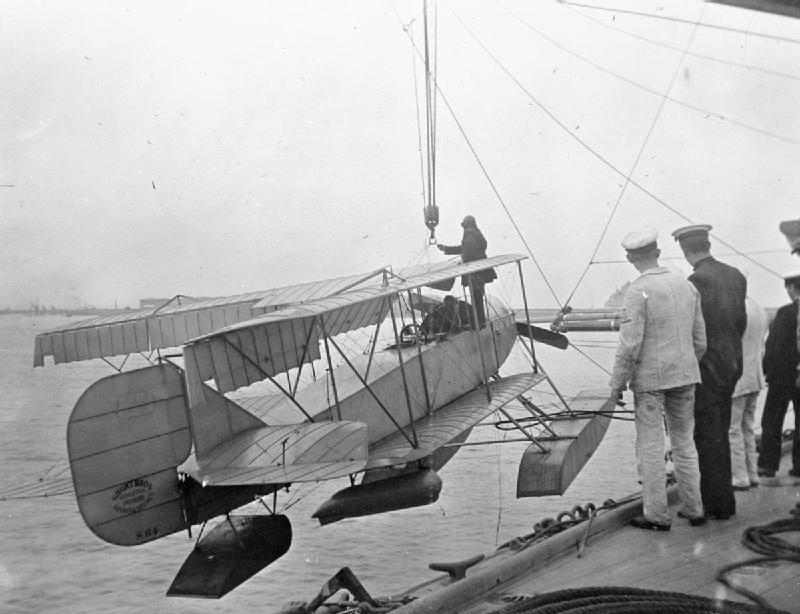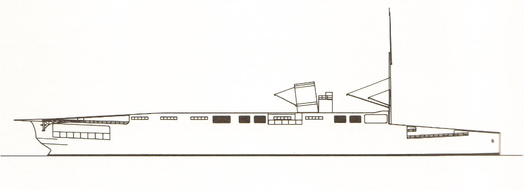Also I wonder if any 1914-15 aircraft would have the power to weight ratio to get airborne in the length of a carrier deck?
Easily. If they can take off from the 100-150 ft of a predreadnought fo'c'sle they can take off from a carrier.
Also I wonder if any 1914-15 aircraft would have the power to weight ratio to get airborne in the length of a carrier deck?
Slight misreading gave me a vision of someone carrying a torpedo on his shoulder and throwing it out the plane.In 1914 dropping bombs mean throwing them out of a cockpit by hand. Carrying a torpedo is impossible and I shudder
The British had a marginally capable torpedo bomber in 1913.The key thing is aircraft capability. In 1914 they would be marginally useful scouts. By about 1915 reasonable scouts and maybe some anti-scout fighters, and maybe by 1916 some limited bombers, then maybe torpedos or heavy bombers by 1918.
It would be hard to justify a dedicated carrier just for that, though a seaplane tender or something like an escort carrier might be useful. It's likely there would be high mechanical and landing losses early on, though later war aircraft were much more robust and relatively reliable.

The issue is not airplanes carrying torpedoes, but aircraft light enough to take off from a carrier but still with enough grunt to do so with a torpedo and fuel capacity to carry it a useful distance. Then you need to have torpedoes that can take the dive into the water and still work, preferably with a useful range. Then you need a targeting system and considerable training in dropping tactics. All that gets you as far as torpedoing near stationary vessels in a harbour. To hit something that is moving takes yet more development and training. That was hard even in WW2.The British had a marginally capable torpedo bomber in 1913.

Short Admiralty Type 81 - Wikipedia
en.wikipedia.org
View attachment 736331
All very true, carrier aircraft WWI technology isn't up to attacking warships at sea. However even a failed attack on the Grand Fleet at Scapa Flow would force the GF to abandon it until defences were improved. That would not break the blockade but it would potentially open up holes in it.The issue is not airplanes carrying torpedoes, but aircraft light enough to take off from a carrier but still with enough grunt to do so with a torpedo and fuel capacity to carry it a useful distance. Then you need to have torpedoes that can take the dive into the water and still work, preferably with a useful range. Then you need a targeting system and considerable training in dropping tactics. All that gets you as far as torpedoing near stationary vessels in a harbour. To hit something that is moving takes yet more development and training. That was hard even in WW2.
People are getting confused on what the blockade was. 90%+ was done in shipping company offices, not on the high seas. Its not a close blockade like in the Napoleonic wars, its mainly paper with some ship patrolling shipping lanes ( for raiders first, blockade runners a distant second ). Most, if not all, of the ships the RN had scouting in the North Sea were trying to intercept submarines or warn of the HSF sailing.All very true, carrier aircraft WWI technology isn't up to attacking warships at sea. However even a failed attack on the Grand Fleet at Scapa Flow would force the GF to abandon it until defences were improved. That would not break the blockade but it would potentially open up holes in it.
Unless this is coordinated with an attempt at blockade running the reaction in the Admiralty will be "Oh no, a couple of AMCs have been sunk, better replace them straight way"People are getting confused on what the blockade was. 90%+ was done in shipping company offices, not on the high seas. Its not a close blockade like in the Napoleonic wars, its mainly paper with some ship patrolling shipping lanes ( for raiders first, blockade runners a distant second ). Most, if not all, of the ships the RN had scouting in the North Sea were trying to intercept submarines or warn of the HSF sailing.
Interesting, also suggests any sudden interest in Naval aviation by the Germans would not be ignored by the British.The British had a marginally capable torpedo bomber in 1913.

Short Admiralty Type 81 - Wikipedia
en.wikipedia.org
View attachment 736331

That may be optimistic, because in the Wiki article I readThis carrier would have been finished had Germany not had submarine priorities towards the end of the war.
The proposed design was completed by 1918, but by then, the majority of naval construction efforts were diverted to building new U-boats.[1] The demands on labor and resources the war imposed on the German economy reduced the shipbuilding industry to barely being able to cover the maintenance and repair needs of the High Seas Fleet. What resources were left over were by 1918 funneled into U-boat production.
To better clarify, that's why I said that if Germany had not gone into unrestricted submarine warfare and had started the project earlier than 1918 the carrier would be more feasible.That may be optimistic, because in the Wiki article I read
One almost certainly not very effective carrier in 1918 would have been a complete waste of resources for Imperial Germany as it faced defeat on the Western Front, an earlier Graf Zeppelin basically.To better clarify, that's why I said that if Germany had not gone into unrestricted submarine warfare and had started the project earlier than 1918 the carrier would be more feasible.
This might provoke the British to develop a long range anti-aircraft weapon capable of hitting a zeppelin-like target at a range of several miles. Imagine the San Shiki shell for Dreadnought main batteries introduced 3 decades earlier.I have seen pictures of attempts to develop an "air torpedo" of sorts--a flying bomb with wings and a pusher propeller. If the Germans could solve the guidance problems involved they might have managed to get some kind of airborne torpedo that dipped into the water (shedding wings and pusher engine of course) and made its way to hit a ship in a final relatively short underwater run. Or alternatively stayed airborne and dived onto a ship at high speed with a lot of high explosive. For guidance I am thinking of radio control, provided it might be possible to design the receiver on the torpedo to only "listen" for signals in a very narrow directional cone pointing back to the mothership Zeppelin, and/or some very primitive form of coded communications--say a chain of metal punch cards containing an index of pulse commands that changes every time one is used, preventing Entente forces from spoofing it. A few commands along the lines of "yaw left (or right) one click", "pitch up (or down)," "crash-dive onto target"--that's 5 there--might suffice; with acceptance of each command the torpedo flashes an acknowledgement and complies, and the index punch card advances a notch, the command airship has an identical chain of command index cards and so they stay synchronized. Then after launching the torpedo a crew member watching both target and drone in a telescope uses the radio to issue these commands as needed to steer the thing to target. Because the torpedo need not take off from the ground, it is dropped from the Zeppelin, its wings can be relatively small and it can proceed at very high airspeed provided the Germans can manufacture a one-shot disposable high energy engine at acceptable cost; range is very short so fuel efficiency is not a major issue nor is fuel supply large. High airspeed near sea level also means cross winds have relatively low effect on trajectory which is why a "veer" command of short duration might be suitable to keep it on track.
An airship just a couple kilometers above sea level would have (weather permitting!) very long lines of sight on enemy warcraft, and so it could stand out of range of developed seaborne artillery to launch the torpedo. Once they have guided one to target they can break off and proceed with airspeed superior to the seaborne speed of any surface unit however "fast" out of range no matter how aggressively the enemy pursues it. The enemy would therefore be forced to develop aircraft to chase the Zeppelin--but here is where objections about the low state of the art of OTL Great War aircraft come into play. Will the RN develop carrier decks of their own to launch pursuit (and indeed preemptive scout) airplanes, or must they rely on seaplanes? Even during the Great War airplanes started out faster than the fastest airships and under such pressures improvement might proceed faster--IIRC some late-war warplanes could fly closer to 200 mph. Whereas airships are not so much restricted in speed by engine power/propeller thrust as such but rather the structural limits of the buoyant hull--whether rigid or fabric-pressure ships, bending moments on it increase rapidly with airspeed, requiring heavier structure to resist which rapidly eats into useful lift. The practical demonstrated speed limits on airships is in the 60-80 knot (30-40 meters/sec) range. Above 60 knots, it is possible but unwise to soup up an airship to go faster--noting also that aside from danger in breaking up, a faster airship must guzzle fuel faster and thus remaining useful lift minus fuel weight, and thus range, would suffer.

For curiosity's sake, do you think that in a Central Powers victory scenario completing the carrier may be a better idea?One almost certainly not very effective carrier in 1918 would have been a complete waste of resources for Imperial Germany as it faced defeat on the Western Front, an earlier Graf Zeppelin basically.
From a torpedo plane that can scarcely take off in 1913 to sinkings from air-launched torpedoes in the second half of 1915 is amazing and at least a year sooner than I'd thought. I learned something today.The British had a marginally capable torpedo bomber in 1913.

Short Admiralty Type 81 - Wikipedia
en.wikipedia.org
View attachment 736331